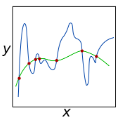A new algorithm of the canonical polyadic decomposition (CPD) presented here. It features lower computational complexity and memory usage than the available state of the art implementations. We begin with some examples of CPD applications to real world problems. A short summary of the main contributions in this work follows. In chapter 1 we review classical tensor algebra and geometry, with focus on the CPD. Chapter 2 focuses on tensor compression, which is considered (in this work) to be one of the most important parts of the CPD algorithm. In chapter 3 we talk about the Gauss-Newton method, which is a nonlinear least squares method used to minimize nonlinear functions. Chapter 4 is the longest one of this thesis. In this chapter we introduce the main character of this thesis: Tensor Fox. Basically it is a tensor package which includes a CPD solver. After introducing Tensor Fox we will conduct lots of computational experiments comparing this solver with several others. At the end of this chapter we introduce the Tensor Train decomposition and show how to use it to compute higher order CPDs. We also discuss some important details such as regularization, preconditioning, conditioning, parallelism, etc. In chapter 5 we consider the intersection between tensor decompositions and machine learning. A novel model is introduced, which works as a tensor version of neural networks. Finally, in chapter 6 we reach the final conclusions and introduce our expectations for future developments.
翻译:此处展示了一种新的光学多元分解算法( CPD) 。 它的计算复杂性和记忆用量比艺术执行的现有状态要低。 我们首先以CPD应用到现实世界问题的一些实例开始。 本文主要贡献的简短摘要如下。 在第一章中, 我们审查古典高温代数和几何, 重点是CPD。 第二章 侧重于 Exor 压缩, 据认为( 在此工作中) 是CPD算法中最重要的部分之一 。 在第三章中, 我们谈论高斯- Newton 方法, 这是用来尽量减少非线性功能的非线性最低平方法 。 第四章是这个理论中最长的一个。 我们在此章中介绍这个理论的主要特征: Tensor Fox。 基本上这是一个包含CPD 解答器的 。 在介绍Tensor Fox 之后, 我们将进行大量的计算实验, 比较这个解析器和其他几个解算器 。 在本章的末尾, 我们介绍Tensor train 最终定位, 并展示如何使用它来构建更高顺序的CPD 。 在最后一章中, 我们讨论一些重要的细节, 正在研究 。




